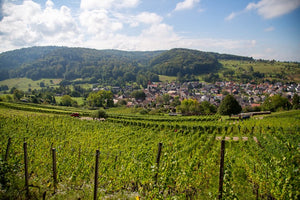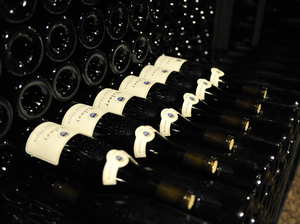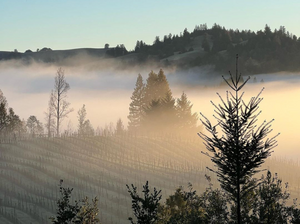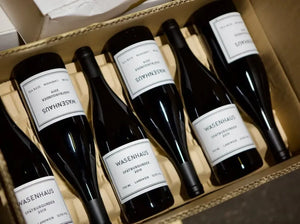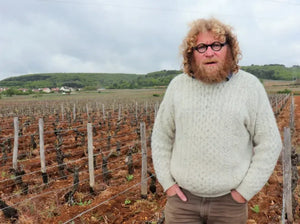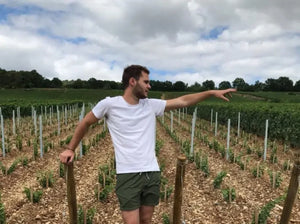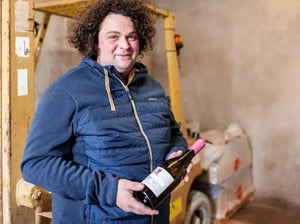Blog » Pinot Noir
-
Baden Benchmark: Enderle & MollSven Enderle and Florian Moll are lucky to farm some of the oldest Pinot Noir in Baden. If there's one under-the-radar Pinot Noir outside Burgundy, still with the same sensibilities and an added natural flair, it's this duo from Germany. Their exacting approach in the vineyard and cellar allows minimal sulfur additions, highlighting the vivid purity of their Pinot Noirs. Neutral barrels for aging come from Domaine Dujac of Morey Saint Denis lore.Liaison, planted in 1970, is spicy, mineral-driven, and ethereal yet saturates the palate—the perfect intro to Enderle & Moll's singular style.Buntsandstein is 1954-planted and shows deeper layers with expansive texture. Powerful yet refined with a long finish.Muschelkalk, sourced from 80-year-old vines on pure limestone soil, is lighter with more tension and chalky minerality.After working across the globe, Enderle and Moll returned home in 2007 with a clear mission: To work in Baden using organic and biodynamic viticulture. The natural wine crowd and critics alike have championed these wines upon their relatively recent release in the U.S. Most notably, Jancis Robinson went as far as to place them in the "cult" category.
-
Bitouzet-Prieur: Classicism Holding Steady
We all have regrets. One of mine was passing on Bitouzet-Prieur Volnay and Meursault when I turned on the lights in 2015. A friend once said, “If you’re not embarrassed by choices made in the previous year, then you’re not growing.” The 2020 vintage of this domaine marks my redemption.
With winemaking medals galore filling the home of Vincent Bitouzet back in 1860, the marriage to Annie Prieur after that marked the official start of what is now the most classic domaine in Volnay, along with Lafarge. And the whites from vineyards like Meursault 1er Cru Charmes and Perrières are now another great reminder that value is alive and well in the Côte de Beaune.
I only have a few wines from Bitouzet-Prieur, but they are the best cuvées to me after an extensive tasting with the domaine in Brooklyn last year. The Volnay is destemmed, and pigeage (punchdowns) occur twice per day—a process that has seemingly gone out of fashion in Burgundy of late as many opt for remontage (pumpovers) to bring softer contours and more immediacy to the fruit. But the 2020 Volnay is pure class and is precisely the type of Burgundy I seek out—from the greatest red village of the Côte de Beaune.
The whites see extended lees contact and a maximum of 20% new oak. They pull back on the fruity Chardonnay traits, instead digging deep for a saturating mineral through-line that reminds me of wines common pre-2005 heat. Still bursting with site-specificity and deliciousness, they take my mind back to another time with their soft-spoken spirit. -
Hirsch Quake: A Record-Breaking VintageFor the first time, the iconic Hirsch Vineyards has allocated the release of their flagship San Andreas Fault Pinot Noir ($78). And it's no surprise why. 2021 marks not only the most successful vintage for Sonoma Pinot Noir in the 21st century but also the best-ever bottling of this wine.
Hirsch sits half a mile from the San Andreas Fault line. With 34 vineyard blocks comprising the eponymous cuvée, this signature blend is the ultimate snapshot of place. As David Hirsch notes, the fragmentation is unmatched even by the famously subdivided vineyards of Burgundy’s Côte de Nuits. The result is a wine exploding with fresh red cherry, strawberry, and mint notes that segue into a precise finish with dark chocolate, orange skin, and dusty minerality.Driving the winding road from downtown Sonoma to the property at the far edge of California’s coast is a rite of passage. I was lucky enough to work one ridgeline over at Failla’s Estate Vineyard, and I can tell you, despite the acclaim of the Pinot Noirs, the extreme Sonoma Coast’s rugged terrain remains built for a few. David was the first to plant Pinot Noir here in 1980, and the location remains completely remote.Producing wines of consistent ripeness and grace in a marginal climate like this one is no easy feat, especially when the grapes are known for having formidable tannins. And yet, that is precisely the tall task that daughter Jasmine Hirsch and Consulting Winemaker Michael Cruse have accomplished.
The style has changed throughout the last twenty years since David built a winery and began putting Hirsch Vineyards on his own label. Today, they have opted for 100% de-stemming across the board and about 30% new oak for this particular cuvée. Again, 2021 is the most successful version of Hirsch’s San Andreas Fault Pinot Noir, and in a vintage where the entire lineup has received “perfect” praise. -
Anything but Ordinaire: Wasenhaus Spatburgunder
The hunt for German Pinot Noir producers who get it is a never-ending pursuit. Much of the point-chasing efforts from estates in Baden (Pinot Noir territory) are overly masked through excessive oak, extraction, and out-of-whack ripeness seemingly intended to elicit oohs and ahs from tasters as if they had finally made that Burgundy-beater. Any German producer intent on outshowing Burgundy would be better suited in another line of work.
Today's afternoon offer is exciting for a couple of different reasons. First, Alexander Götze and Christoph Wolber have spent over a decade working at Burgundian domaines like Leflaive, De Montille, Pierre Morey, and Comte Armand. Secondly, I have fond memories of spending time with Alex during my year-long stint in Beaune. His goal was always to return to Germany and produce Pinot Noir that followed the sensibilities that the Côte d'Or naturally transmitted.
Wasenhaus is Pinot Noir at its most ethereal. For me, the entry-level bottling, Grand Ordinaire, is the highlight of the lineup. The delicacy and levity here brought an up-front drinkability and ease that's undeniably delicious and equally brilliant. No doubt, the duo's experience in Burgundy imparted an important lesson: That great wine is made in the vineyard and raised with a soft touch in the cellar.
Much of the elegance in the Wasenhaus range can be attributed to working with vineyards with a higher content of limestone and sand versus the heavier clay soils that are more common throughout Baden. As you can imagine, those with an eye toward grace above power will choose their sites wisely.
The Spätburgunder ferments with 90% destemmed fruit and 10% whole clusters. Aging takes place in neutral barrel for one year, followed by six months in stainless steel. This switch really benefits the wine as it holds in those more crunchy and bright red berry fruit characteristics. The lingering finish with sweet brown spices and savory tones is persistent, especially given the humble price point.
I'm always up for tasting German Pinot Noir, but I rarely find wines that pull me in like red Burgundy. For Wasenhaus, it's the effortless sensibility and focus on terroir that shines the brightest. -
Designations be Damned: Sylvain Pataille Marsannay
Sylvain Pataille is famous for three things: Producing some of the most texturally seamless and balanced wines in the Côte de Nuits, his oenologist consulting for over 15 domaines, and having really awesome hair. My visit to the domaine was a terroir masterclass, as we tasted over 20 wines from Marsannay.
Marsannay and Pataille are a match made in heaven. Both have seemingly flown under the radar for far too long. Search through any savvy Burgundy collector's cellar, and next to the Rousseau and Dujac, you're sure to find a host of Pataille's Marsannay. This village located above Gevrey Chambertin has a complicated history, though. Mainly planted with Gamay at the time of classifications, no vineyards could receive a status higher than villages.
Today, Clos du Roy would undoubtedly be a Premier Cru, and it's a steal within the hierarchy of Burgundy's elite. There's never shyness here, always finding that elusive mix between power, elegance, and silken tannins without overt new oak influence. And, believe it or not, Le Chaptire's historical pricing in the 16th century was only surpassed by Chambertin-Clos de Beze. It's still among the ultimate insider lieu-dits and an equally worthy cellar mate with Clos du Roy. -
Leaping Over Legacy: Pierre Girardin Bourgogne
Vincent Girardin's name was synonymous with Burgundy's breadth, with wines coming from enviable vineyards throughout the Côte d'Or. Although the vast terroir had undeniable gems from Grand Crus and Premier Crus, the large production made for boring wines. When Vincent sold the domaine in 2011, he kept 4.5 hectares of the top holdings for his son, Pierre. After spending time in the vines, cuverie, and cellar from a very young age, the 21-year-old Pierre wanted to take a different philosophical path with his label. He was determined to be associated with the highest quality work––albeit with much more limited availability.
As the cuvée's label suggests, calcaire (limestone) is what Pierre wants to express, and the lens of terroir is in focus with these terrific Bourgogne wines. Pierre's methods highlight freshness and finesse––a rare move was selecting considerably larger 456L barrels for aging and favoring punchovers (as opposed to punchdowns) for the reds to keep their tannins silken. The value proposition in Burgundy is one that we bring up a lot. No doubt, pricing keeps climbing, but the emergence of new values is always around the corner. Pierre Girardin is a name that delivers in a big way with a relatively low price tag, given the quality and terroir. -
Burgundy Fireworks: Yann Charlopin-Tissier
A June 2016 visit in Burgundy meant tastings with some of my favorite storied domaines like Mugneret-Gibourg and Denis Bachelet, but it was after a lunch with Jeremy Seysses at Domaine Dujac and a beautiful bottle of 1993 Clos de la Roche that I got tipped off to something happening across the street—the new Domaine Charlopin-Tissier.
Yann Charlopin-Tissier’s background is surrounded by legendary figures. His father, Philippe Charlopin, was a student of Henri Jayer as he started his own domaine in 1978. Yann worked closely with his father starting in 2004, and then with another mentor, Jean-Marie Fourrier, before launching his own domaine, now at just 4 hectares. Like these Vosne-Romanée and Gevrey Chambertin mythic names, Yann favors picking as ripe as possible and prefers de-stemming.
Yann filled me in on his methodical and organic approach to viticulture, his excruciatingly low yields, and his disdain for talking too much about winemaking choices in the cuverie. "These wines are made in the vineyard," he would repeat. And the dirt under his nails, and muddy boot prints littered throughout the courtyard drove home that point. For me, this image greatly juxtaposed with what you find in bottle––suave and sophisticated texture, luxurious mouthfeel, supported by very concentrated ripe fruit buffered with mouth-watering salinity.
My two favorite wines of the 2020 vintage capture precisely what is so special here: The Marsannay La Montagne is surely the sleeper pick in the range, but this lieu-dit coming from the top of the slope in Marsannay where it is substantially rockier than below offers a masterclass in balance, between bold, ripe, dark fruit with powdery tannins and mineral finish. The Pernand Vergelesses Sous Frétille is one of best kept secrets in Premier Cru white Burgundy. Always a site that delivers crisp salinity and a Grand Cru-level drama. Yann’s version has a ruthless intensity of fruit with a chalky grip that is truly head-turning. This reflects his ambition for powerfully concentrated wines that still somehow have a wizardly refinement on the palate.
.svg?v=162776257677185172071677832259)



